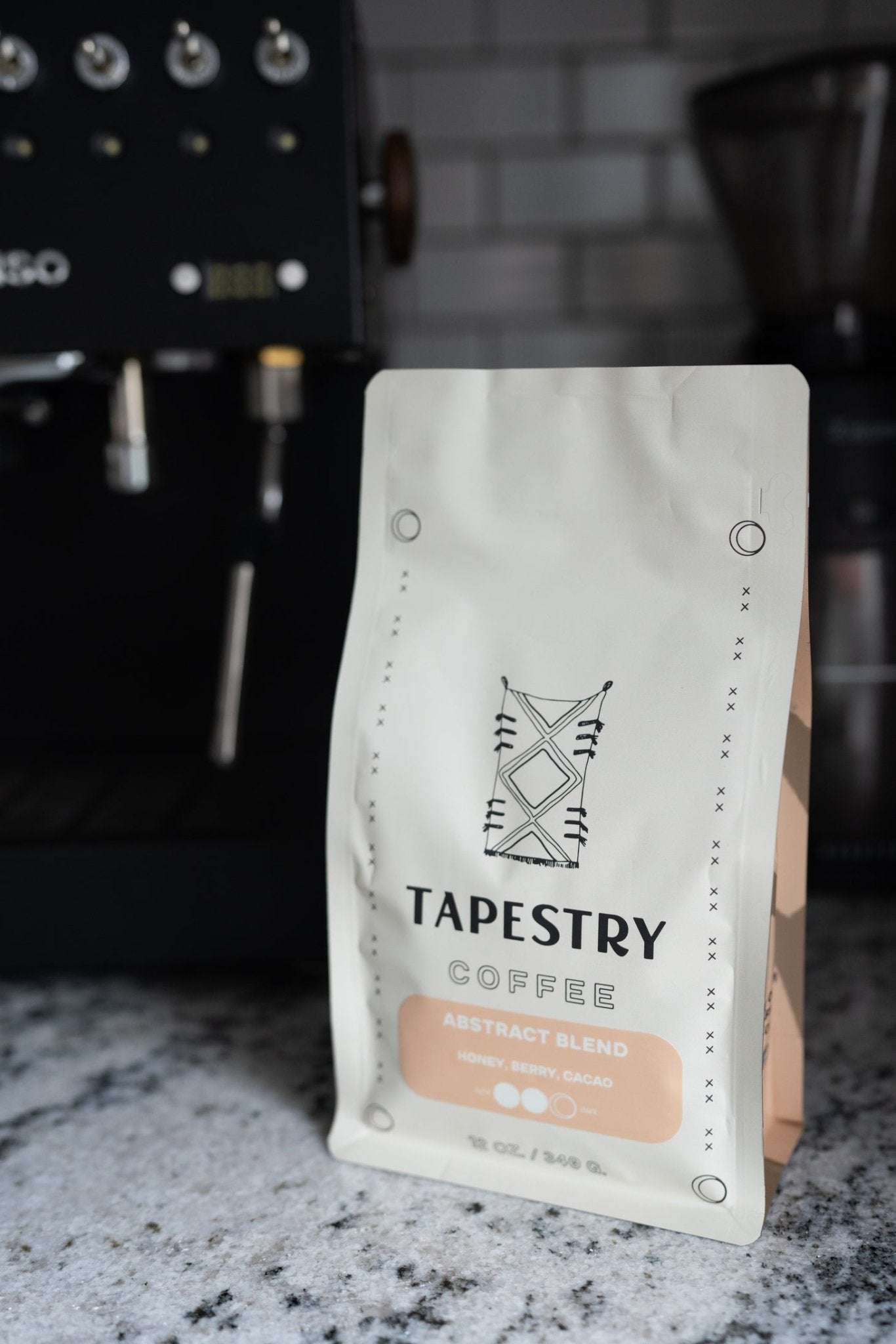In the world of coffee, there's more to a bag than just the promise of a morning pick-me-up. Behind those carefully designed labels lies a tapestry of information, each thread contributing to the unique flavor experience in your cup. As you embark on the journey from coffee beans to that delightful sip, understanding the language on the bag becomes paramount.
In this exploration, we'll delve into the key elements that adorn the packaging of your favorite brew at Tapestry Coffee. From the nuances of single-origin beans to the symphony of blends, we'll decipher the mysteries behind country of origin, roast level, and flavor notes. So, the next time you find yourself standing in the coffee aisle, you'll be equipped with the knowledge to make a choice that suits your palate and preferences.
Coffee appreciation is an art, and the label on your coffee bag is your guide through this rich and diverse landscape. Let's unravel the layers then truly understand the intricate details that make each cup a unique and flavorful experience. Welcome to the world of decoding your coffee bag!

Single Origin vs. Blend
One of the first distinctions you'll encounter is whether the coffee is a single origin or a blend. These terms might seem like coffee jargon, but they carry profound implications for the flavors dancing in your cup.
A. Single Origin Unveiled
Single-origin coffee is akin to sipping a specific terroir – the taste reflects the unique characteristics of beans grown in a particular region, often a single country or even a specific estate. The beauty of single origin lies in its purity. They allow you to embark on a flavorful journey that captures the essence of a specific locale. As you explore this category, anticipate distinct flavor profiles and then nuances that showcase the country's influence on the coffee beans.

Unique Flavors and Characteristics:
Single-origin coffees boast distinct flavor notes that tell a story of their origin. From the citrusy brightness of Ethiopian Yirgacheffe to the chocolaty richness of Colombian beans, each cup is a passport to a different corner of the coffee world.
Connection to a Specific Region:
By opting for single-origin coffee, you're not just sipping a beverage; you're immersing yourself in the culture, climate, and altitude of a particular coffee-growing region. This connection enhances the overall coffee experience, turning it into a sensorial journey.
B. The Art of Blending
On the flip side, blends are a carefully orchestrated symphony of beans from different origins. They are crafted with precision to achieve a harmonious balance of flavors. Blending offers roasters the opportunity to create a consistent taste profile, ensuring that every cup delivers a reliable and enjoyable experience.
Combining Beans for Balance and Complexity:
Blenders play the role of coffee maestros, selecting beans with complementary flavors to create a well-balanced and complex cup. The result is a harmonious marriage of acidity, body, and sweetness. It allows a coffee where no single note overwhelms the others.
Highlighting the Art of Blending:
The art of blending is a testament to a roaster's skill. By artfully combining beans, roasters can achieve a level of consistency that appeals to those seeking a reliable and familiar flavor.
As you stand before the coffee aisle, armed with the knowledge of single origin and blends, you can now make a choice that aligns with your preferences. Whether you crave a single origin or a blend, the label on your coffee bag is your gateway.

Country of Origin: Unveiling the Flavor Map
Embarking on our exploration of the coffee label, we now journey into the heart of the coffee world – the country of origin. This pivotal detail unveils a rich tapestry of flavors, shaped by the unique geography and climate of each coffee-producing region.
Distinctive Profiles from Different Regions
Understanding the Impact of Geography:
Geographical nuances play a pivotal role in determining the flavor profile of coffee. From the rugged landscapes of South America to the lush terrains of Africa, the soil, altitude, and climate contribute to the tasting notes.
Spotlight on Renowned Coffee-Producing Countries:
Typical Tasting Notes: Known as the birthplace of coffee, Ethiopian beans often boast fruity and floral notes. They typically also have a wine-like acidity. Explore the vibrant flavors of berries, citrus, and jasmine in a cup of Ethiopian coffee.

Colombia:
Typical Tasting Notes: Colombian coffees are celebrated for their well-balanced profiles. Expect a medium body with bright acidity. They are also known for notes of caramel, nutty undertones, and a hint of citrus.
Brazil:
Typical Tasting Notes: As the largest coffee producer globally, Brazilian beans often deliver a full-bodied, low-acid cup with flavors of chocolate, nuts, and a subtle sweetness.

B. Altitude and Climate: The Architects of Flavor in a Coffee Bag
Altitude's Influence on Acidity and Sweetness:
High-Altitude Coffees (e.g., Ethiopia, Kenya): Experience coffees grown at higher altitudes, showcasing pronounced acidity and nuanced sweetness, with tasting notes ranging from bright citrus to delicate florals.
Low-Altitude Coffees (e.g., Brazil, Indonesia): Explore the fuller-bodied, less acidic profiles of beans cultivated at lower elevations, often featuring chocolatey, nutty, or earthy flavors.
Climate Affecting the Overall Flavor Profile:
Tropical Climates (e.g., Central America): Coffees from these regions often exhibit bright acidity and lively fruit notes, reflecting the warm, humid conditions.
Arid Climates (e.g., Ethiopia's Harrar region): Also discover coffees shaped by dry, arid climates, presenting bold and intense flavors with a rich body.
The label on your coffee bag now transforms into a map. As you read, let it guide you through the diverse landscapes that contribute to your favorite brew's unique personality. As you savor each cup, envision the journey from the sun-soaked hills of Colombia to the misty highlands of Ethiopia.
Roast Level: Crafting the Perfect Flavor Profile
With the foundation of single origin, blends, and the country of origin laid out, our exploration of the coffee label takes a turn toward the roasting process. And the roast level is a crucial factor that can dramatically influence the flavor and aroma of your coffee. Let's delve into the art and science behind roasting and decode the language of light, medium, and dark roasts.
A. Overview of the Roasting Process
From Green Beans to Aromatic Coffee:
The journey begins with green coffee beans, raw and unassuming. Roasters apply heat, skillfully transforming them into the aromatic gems we know as coffee. Understanding this process unveils the magic that occurs within the roasting drum.
Importance of Timing and Temperature:
Roasting is a delicate dance of timing and temperature. The roaster's expertise lies in navigating the fine line between underdeveloped and burnt beans. This ensures the perfect balance to bring out the desired flavors.
B. Breakdown of Roast Levels
Light Roast: Characteristics and Flavor Notes:
Characteristics: Light roasts retain more of the bean's original flavors, showcasing bright acidity and a lighter body. Additionally, Light roasts also contain more of the natural caffeine.
Typical Flavor Notes: With nuances of tea-like qualities, delicate floral and fruity notes shine through. Common descriptors include citrus, berries, and floral undertones.
Medium Roast: Balancing Acidity and Body:
Characteristics: A balance between acidity and body, medium roasts offer a more rounded flavor profile.
Typical Flavor Notes: Expect a nuanced combination of fruit, chocolate, and nutty tones. The acidity is still present but is complemented by a fuller body. Therefore, medium roasts create a versatile and crowd-pleasing cup.
Dark Roast: Bold Flavors and the Impact on Acidity:
Characteristics: Dark roasts bring out robust and bold flavors with a diminished acidity.
Typical Flavor Notes: Rich, smoky, and often exhibiting caramelized sugars, dark roasts boast intense flavors of chocolate, toasted nuts, and sometimes hints of spice.
Understanding roast levels empowers you to choose a coffee that aligns with your flavor preferences. Whether you gravitate toward the bright vibrancy of a light roast or the bold richness of a dark roast, the label on your coffee bag now serves as a roadmap to the diverse and complex world of roast profiles. As you sip, appreciate the craftsmanship that went into transforming humble green beans into the aromatic elixir in your cup.

Image Credit to I Love Coffee
As we continue our journey through the elements of a coffee label, we arrive at a section that adds a layer of sensory delight – flavor notes. Much like a sommelier describing the notes of a fine wine, coffee roasters use flavor notes to articulate the unique taste experiences awaiting you in each cup. Let's explore how these notes are determined, what they mean, and how you can navigate the rich tapestry of flavors.
A. Explanation of Flavor Notes on Coffee Labels
How Roasters Determine and Describe Flavors:
Tasting Panels and Expertise: Roasters employ skilled tasters. And they often conduct tasting panels to identify and describe the nuanced flavors present in each batch.
Artistic Language: The language used to describe flavor notes can be diverse and artistic, encompassing a range of descriptors from floral and fruity to chocolatey and spicy.
Common Descriptors and What They Mean:
Fruity and Floral: Notes of berries, citrus, or floral undertones often indicate a coffee's origin or the specific varietals present.
Chocolate and Nutty: Also roasters may highlight the inherent sweetness and richness of the beans with descriptors like chocolate, caramel, or nutty.
Spicy and Earthy: Whereas some coffees exhibit spicier or earthier notes, providing a unique and complex flavor profile.

Image Credit to The Specialty Coffee Association of America
B. Tasting Tips for Consumers
Developing a Palate for Nuanced Flavors:
Sip Slowly and Savor: Take small, deliberate sips to fully experience the spectrum of flavors. Then let the coffee coat your palate, allowing the nuances to unfold.
Experiment and Compare: Also try different coffees side by side to compare and contrast flavor notes. This exploration can enhance your ability to identify and appreciate distinct tastes.
Experimenting with Different Coffee Varieties:
Single Origin Exploration: Delve into the world of single origin coffees to experience the pure, unadulterated flavors associated with specific regions.
Blends for Complexity: Then explore blends to enjoy a medley of flavors, where the artful combination of beans results in a harmonious and well-rounded cup.
Next as you navigate the flavor notes on your coffee label, consider it an invitation to a sensorial adventure. The descriptors are not just words; they're a bridge connecting you to the intricate dance of flavors within your coffee cup. Armed with this knowledge, embark on your coffee-tasting journey with a heightened appreciation for the symphony of tastes that await.
Conclusion: Deciphering Your Coffee Bag
Finally, in this exploration of the elements on your coffee bag label, we've ventured through the intricate details that transform a simple bag of beans into a gateway to a world of flavor. The journey began with the choice between single origin and blends, offering insights into the unique narratives each option weaves. From there, we traversed the globe, unraveling the secrets of the country of origin and how geographical nuances shape the coffee in your cup.
Roast levels added another layer to our understanding, as we appreciated the art and science behind transforming green beans into the aromatic elixir we cherish. Then, we delved into the sensory delights of flavor notes, deciphering the language roasters use to articulate the rich tapestry of tastes awaiting your palate.
Lastly, as you stand before the coffee aisle, armed with the knowledge of single origin or blends, country of origin, roast levels, and flavor notes, the label on your coffee bag becomes more than just information – it's a compass guiding you toward a personalized and delightful coffee experience. So, with every sip, celebrate the diversity, craftsmanship, and stories encapsulated within that humble bag of coffee.

